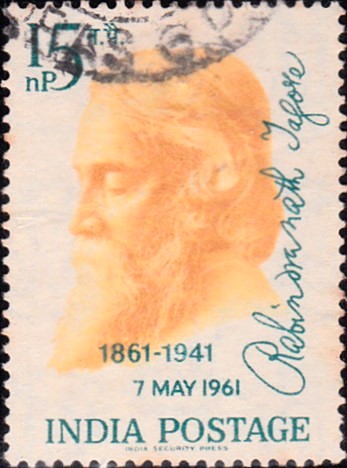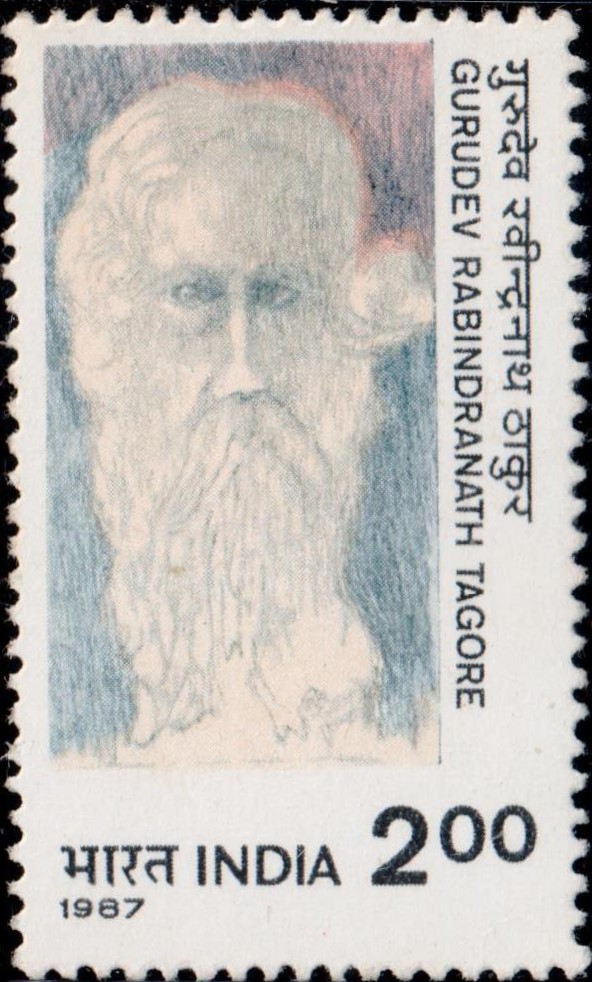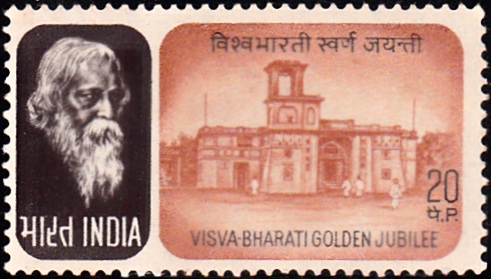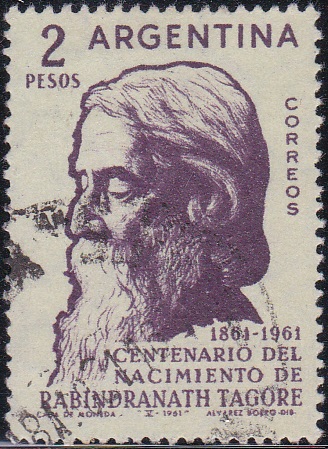
India on Rabindranath Tagore 1961
A commemorative postage stamp on the Birth Centenary of Kabiguru Rabindranath Thakur, 1st non-European to win Nobel Prize in Literature in 1913 :
 Issued by India
Issued by India
Issued on May 7, 1961
Issued for : In 1952, the Posts and Telegraphs Department brought out the first photogravure series of stamps depicting Saints and Poets which included Rabindranath Tagore. The Department deems it a great privilege to pay its tribute to this great Poet of India once again by issuing a special stamp commemorating his birth centenary.
Design : The stamp which carries the profile of Rabindranath Tagore is based on a design by Satyajit Ray and is executed by the India Security Press, Nasik.
Acknowledgements are due also to the Vice-Chancellor, Vishwa-Bharati, for kind permission to use the profile from a photograph.
Type : Stamp, Postal Used
Colour : Chestnut – Jade Green
Denomination : 15 Naya Paisa
Size : 3.91 X 2.90 cms.
Perforation : 13
Watermark : All over multiple “Lion Capital of Asoka”
Number Printed : 2.5 million
Set : 35 stamps per issue sheet
Printing Process : Photogravure
Name : Rabindranath Tagore
Born on May 7, 1861 at Kolkata, India
Died on Aug 7, 1941 at Kolkata, India
About :
- “He has left us the Gitanjali, the poems which brought him world fame. The great Tulsidas left us his immortal Ramayana. The renowned Vedavyasa left a history of mankind. They were not mere poets, they were teachers. Gurudev, too, wrote not only as a Poet, but as a Rishi …. His creative genius has also given us Santiniketan, Sriniketan and Vishwa-Bharati. These breathe his spirit and are a legacy not only to Bengal but to India. Santiniketan has become a place of pilgrimage to us all …. They are monuments to his endeavour and are a constant reminder to us of the passionate love he had for his country and the service he rendered to her.” (Gandhiji, at a birthday observance in May 1946.)
- My pictures are my versification in lines. If by chance they are entitled to claim recognition it must be primarily for some rhythmic significance of form which is ultimate, and not for any interpretation of an idea, or representation of a fact. – Rabindranath Tagore
- A Poet’s Mission
- “A poet’s mission is to listen for the voice which is not yet audible; to inspire faith in a dream which is still unfulfilled, to bring to a sceptic world the earliest tidings of the unborn flower. It is the eternal child, the dreamer, the courageous man of simple faith who has given the impulse to great civilizations. The faith of such a creative genius acknowledges no limits. Age after age, in Asia, great dreamers have made the world sweet with the showers of their love and wisdom. Asia is again waiting for such dreamers to come and carry on the work, not of fighting, not of selfish profit-making, but the work of overcoming all differences, of widening for ages, of producing the light that pierces the storm clouds of trouble, that illuminates the path of life.” – Rabindranath Tagore
- Rabindranath Tagore (1861-1941)
- 1961 marks the centenary of the birth of four great Indians – Rabindranath Tagore, Motilal Nehru, Madan Mohan Malaviya and Profulla Chandra Ray. Each one of them made notable contributions to Indian national development and they all shared the great qualities of patriotism, nationalism and humanism. They believed in the freedom and dignity of the individual and held that India‘s greatest gift to the world lay in emphasising these human values. Even among these resplendent figures, Rabindranath Tagore is pre-eminent as a man of extraordinary genius whose contributions to India and the world are outstanding.
- Tagore was fortunate in both the time and the place of his birth. The advent of the West had disturbed the placid waters of Indian life, and a new awakening was seeping throughout the land. Its initial impact had dazzled the Indian mind and so impressed some of the early reformers that, at times, they seemed to blind imitators of the West. By the time Tagore was born, the first phase of uncritical admiration for the West had worn off and there was a more balanced appraisal of its values. Simultaneously, there was increased knowledge of and regard for the values of the East. The place of his birth was equally appropriate. Bengal had felt the influence of the West earlier and more vigorously than, perhaps, any other part of India, and in Bengal the stirrings of new life were most marked in Calcutta. The meeting of the East and the West on India‘s shores was for Tagore, thus, both a fact and an ideal.
- The circumstances of his family also helped in the flowering of Tagore‘s genius. Originally from East Bengal, the family became rich and prosperous during the later Mughal days. Its affluence became even greater after the coming of the British. Co-operation with the ruling powers brought it status, wealth and culture, but it also provoked the disapproval of the orthodox. Inter-dining with the Tagore family invited social disapproval, intermarriage – ostracism. Conscious of its wealth and talents, the family reacted with a proud unconcern for many of the social taboos of the day. The family had been moved, however, for generations by the deeper values of Indian life. Tagore‘s grandfather was one of the pioneers of Western education and a friend of Raja Rammohan Roy. His father, a great student of Indian philosophy and Islamic mysticism, began his day with recitations from the Upnishads and from Hafiz. Tagore was, thus, born in a family which was steeped in the traditions of ancient and mediaeval India and yet, responsive to the currents of the modern West. A profoundly religious atmosphere, free from adherence to forms and rituals, created an ideal background for the flowering of his universal mind.
- In this brief account, we can do little more than barely refer to his many-splendoured genius. The world rightly honours Rabindranath Tagore as one of the greatest literary figures in history. His writings include more than a thousand poems and two thousand songs, in addition to a large number of short stories, novels, dramatic works and essays on diverse topics. As a writer of lyrics and songs, he has rarely been equalled and, perhaps, never surpassed. As a short story writer, his rank is among the first three or four masters of the craft. As a novelist and playwright, he has achieved for himself an honoured place in the world of letters. As a literary critic, he has given evidence of rare insight and deep sympathy with the work of men who differed from him widely in tradition and temperament. It is, thus, not surprising that his works should be translated into all the major languages of the world, and bring joy, solace and strength to countless millions.
- The diversity of his literary work is amazing; but literature in its widest sense could not exhaust his energies. He was a musician of the highest order and not only composed songs but set them to music. He started as a traditionalist, but very soon the range of his musical composition expanded till it incorporated elements from Western music and fused them with his Eastern background. With more than two thousand songs that express every nuance of human feeling and every mood of Nature in her infinite variety to his credit, he is undoubtedly one of the greatest song writers and musicians that the world has known.
- Tagore took to painting when he was almost 70 and yet produced within ten years almost 3,000 pictures. They broke away sharply from prevailing Indian styles and explored the unconscious and sub-conscious levels of the people’s mind. Some regard his work as a complete departure from the India tradition and, yet, many competent critics have described him as one of the most significant and creative painters of modern India. His affiliation with primitive art on the one hand and with some of the avant garde on the other is only one indication of the sweep and range of his genius.
- Tagore was an artist par excellence and, in addition, he made remarkable contributions to religious and educational thought, to politics and social reforms, to moral regeneration and economic reconstruction of India and the world. He not only pondered deeply and creatively on all these topics, but also set his hand to realise in practice what he preached. The educational ideas which inspired his school at Santiniketan have deeply influenced all modern educational thought in India. His programmes of economic, social and political reconstruction of the village through the co-operation and self-help of villagers have set the pattern for programmes of re-construction of national life in contemporary India. He travelled far and wide to revive India‘s contacts with the outside world and laid the foundation on which free India has, since, based her policy of friendly relations with all peoples of the world. His deep feeling for the unity of man made him realise that interdependence of peoples and countries rather than independence must be the principle of life and progress today and tomorrow if the world is to survive the challenge of modern science and technology. Steeped in the age-old traditions of the East, and inheritor of the rich cultural heritage of ancient and mediaeval India, he was at the same time a modernist who welcomed the true values proclaimed by the West. In short, Tagore lived and worked for the realisation of the ideal of Universal Man.
- Humayun Kabir, Minister for Scientific Research and Cultural Affairs, Government of India, New Delhi.








good work.
ya realy.
this pic. is looking so nice..
Hi, This is a wonderful resource. I have this particular stamp in me collection.
[…] 60s. He was also an accomplished composer and added to Indian film music his interpretations of Rabindra Sangeet. He scored music for films such as Anandmath, Nagin, Kohraa and Bees Saal Baad. In Nagin he […]